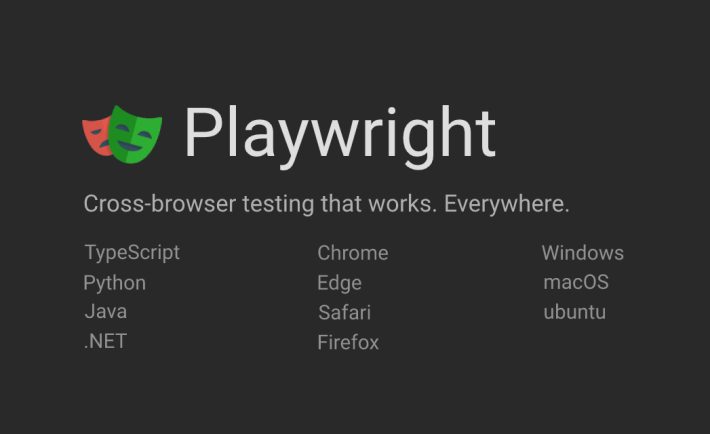
As the demand for test automation tools continues to rise, developers and testers are constantly looking for the best solution to meet their needs. Playwright, a relatively new entrant in the test automation space, has gained popularity due to its unique features and capabilities.
LambdaTest is a cloud-based unified intelligent digital experience testing platform that allows developers and testers to perform real-time and automation testing with various test automation tools, including Playwright, Selenium, and many more. With LambdaTest, you can perform automated tests over a wide range of 3000+ browsers and OS configurations, ensuring your application functions seamlessly across different platforms.
Now through this article, we will compare Playwright with other popular test automation tools in 2023 to help you decide which tool to choose for your testing needs.
We will cover various aspects of these tools, such as ease of setup, programming languages supported, browser support, parallel testing capabilities, cross-browser testing capabilities, execution speed, community support, and cost. So, whether you are new to test automation or looking to switch to a new tool, this comparison will provide valuable insights to help you make an informed decision.
Introduction to Automation Tools and Their Role
Automation tools are software programs designed to perform repetitive and time-consuming tasks without human intervention automatically. In the context of software development and testing, automation tools are used to automate various testing processes, such as functional, load, performance, and regression testing.
The role of automation tools is to streamline the testing process, improve testing accuracy, and reduce the time and effort required to test software applications. By automating testing tasks, developers and testers can focus on more complex and challenging aspects of the testing process, such as exploratory testing and debugging. Automation tools also help ensure consistent testing results, regardless of the tester’s experience or level of expertise.
Furthermore, automation tools can provide faster feedback on the quality of software applications, allowing developers to identify and address defects earlier in the software development lifecycle. This can lead to faster time-to-market and reduced costs associated with software defects discovered late in the development cycle or after the software has been released.
A Bit About Playwright
Playwright is an open-source test automation tool that enables developers and testers to automate the testing of web applications across multiple browsers and platforms. Microsoft developed it and provides a fast, reliable, and scalable solution for end-to-end testing of web applications.
Playwright is built on top of the Chromium and Firefox browser automation libraries and provides a high-level API that is easy to use and understand. It supports multiple programming languages, including JavaScript, TypeScript, Python, and C#. It also supports various testing frameworks, including Jest, Mocha, and Jasmine, making it easy to integrate with existing testing workflows.
The role of the Playwright is to simplify and streamline the testing process by providing a robust and reliable tool for automating web application testing. Its key responsibilities include:
- Cross-browser testing: Playwright supports multiple browsers, including Chromium, Firefox, and WebKit, allowing developers and testers to test web applications across various platforms and browsers.
- End-to-end testing: Playwright supports end-to-end testing of web applications, including testing user interactions, network requests, and browser events.
- Scalability: Playwright provides parallel testing capabilities, allowing tests to be executed concurrently, reducing test execution time, and improving overall testing efficiency.
- Reliability: The playwright provides reliable and stable testing capabilities, ensuring that tests are executed consistently and accurately.
Playwright vs. Other Test Automation Tools: A Comparison for 2023
Choosing a suitable test automation tool can be challenging, especially with the myriad of options available in the market. In this section, we will compare Playwright with other popular test automation tools in 2023 to help you reach your desired tool.
Playwright Vs. Selenium

1. Prerequisites
Selenium requires a standalone Selenium server or Client Language Bindings and browser drivers to be installed. On the other hand, Playwright only requires NodeJS to be installed, and it can be quickly started by installing Playwright using npm or yarn. Playwright will automatically download the required browsers, making it easier to get started with testing. This makes Playwright a more straightforward and accessible option for developers who want to get started with test automation quickly.
2. Languages Supported
Talking about language support, Selenium has the edge over Playwright. Selenium supports a broader range of programming languages, including Python, Java, JavaScript, C#, Ruby, and PHP. On the other hand, Playwright currently supports JavaScript, TypeScript, Java, Python, and .NET.
Having support for multiple programming languages can be crucial for organizations that use a variety of programming languages in their development environment. This makes Selenium a better fit for teams with diverse language requirements. However, for teams that primarily use JavaScript, TypeScript, or Python, Playwright is still a viable option due to its excellent support for those languages.
3. Test Runner
Playwright offers a built-in test runner, which is powerful and flexible. It also supports third-party test runners like Jest-playwright, AVA, and Mocha. This provides developers with various options when it comes to testing runners, making it easier to choose the one that best fits their needs.
Selenium, on the other hand, offers Selenium IDE for creating tests, but it requires the use of the Selenium Command Line Runner or Selenium SIDE runner to run these tests. While these runners are powerful, they don’t offer the same level of flexibility as Playwright’s built-in test runner.
4. Element Locators
Regarding element locators, both Selenium and Playwright offer potent options, but there are some differences. Selenium supports a variety of locators, including Id, Name, Class, Link Text, Partial link text, Xpath, and CSS. Additionally, Selenium 4 introduced “relative locators” to allow users to specify element locations relative to other elements. However, there can be some flakiness with these locators, as Selenium assumes they are already loaded on the page.
On the other hand, Playwright uses its Locator API to find and interact with elements. It provides a range of built-in locators such as page.getByText(), page.getByLabel(), page.getByTitle(), etc., which make it easy to locate elements on a page. Playwright also supports filtering locators by text with the locator.filter([options]) method, allowing users to search for a particular string somewhere inside the element, possibly in a descendant element, case-insensitively. So, Playwright’s Locator API makes it easier and more reliable to find and interact with elements on a page.
5. Waits
Selenium requires different types of waits, like implicit and explicit waits, to handle the active, real-time state of the DOM, which can lead to flaky tests. In contrast, Playwright provides a built-in auto-wait strategy that performs actionability checks on the elements before making actions. This ensures that the actions behave as expected and eliminates the need for manual waits. If the required checks do not pass within the given timeout, Playwright throws a TimeoutError, further reducing flakiness.
6. Parallel Test Execution
Parallel testing is a crucial aspect of test automation that helps reduce the overall test execution time and improve testing efficiency. Both Playwright and Selenium provide parallel testing capabilities, but there are some differences in how they achieve this.
Playwright comes with parallel testing capabilities out of the box, allowing tests to be executed concurrently. On the other hand, with Selenium, parallel testing can be achieved using third-party solutions such as TestNG or Selenium Grid for advanced and scalable parallel testing.
Playwright also offers more flexibility in parallel testing, allowing for test scenarios that span multiple tabs, origins, and users. Playwright can also create scenarios with different contexts for different users and run them against your server, all in one test, making it easier to manage and execute tests.
Playwright Vs. Cypress

1. Error Handling
In the case of error handling, Playwright has an advantage over Cypress. In Cypress, if a command fails, all remaining commands are not run, leading to the test’s failure. Cypress does not support built-in error recovery from a failed command, and there is no way to add a “.catch” error handler for failed commands.
On the other hand, Playwright is more flexible and provides support for a try-catch handler, allowing for more robust error handling in test automation. This can save a lot of time and effort in debugging test failures, making Playwright a more reliable option for testing complex web applications.
2. Parallel Execution
While Cypress executes all its commands serially to ensure consistent behavior for each test run, it does not support parallel execution of commands, which is a common behavior for promises. In contrast, Playwright supports parallel execution of commands, which can significantly boost test execution time and improve testing efficiency. This makes Playwright a better option for projects that require faster test execution and increased scalability.
3. Multi-Browser Support
Playwright has a distinct advantage over Cypress regarding multi-browser support. While Cypress is limited to running tests in a single browser at a time, Playwright enables developers to execute their test suites simultaneously across multiple browsers. This means that Playwright can help ensure cross-browser compatibility more effectively since developers can easily verify that their web application is functioning correctly across various browser environments.
Additionally, Playwright provides seamless cross-browser testing capabilities, allowing tests to be run across multiple browsers with ease.
4. iFrames Support
Playwright’s native support for iFrames provides developers and testers with a more comprehensive way of handling iframes in their tests. In contrast, Cypress’s limited support for iframes may require additional workarounds or custom code to be written to handle them properly. This makes Playwright a better option when testing web applications that heavily use iframes.
5. Soft Assertion
Soft assertions are essential in automation testing, allowing for non-breaking failures and more flexibility in test cases. Unfortunately, Cypress does not support soft assertions, meaning that when an assertion fails, the entire test case stops running. In contrast, Playwright does support soft assertions, which enable more tentative or optional conditions to be tested without causing the whole test case to fail.
Playwright Vs. Puppeteer
1. Language Support
Playwright offers broader language support compared to Puppeteer. Playwright supports Python, Java, JavaScript, TypeScript, and .NET, making it more versatile for developers who prefer different programming languages. On the other hand, Puppeteer is only available in JavaScript, although there is a non-official port for Python called Puppeteer. This difference in language support can be a critical factor in choosing the right tool for test automation.
2. Browser Support
Playwright and Puppeteer have differences in their browser support. Playwright has a cross-browser support feature, which allows for cross-browser testing with device emulation out of the box. It supports Chrome/Chromium, WebKit (the browser engine for Safari), and Firefox. This feature makes Playwright suitable for testing on different browsers and devices, including iOS.
Playwright also has access to the latest browser features and technologies and uses patched browser versions, allowing users to test their code against different browser versions. It also supports multi-context browsing for working with multiple pages or iframes simultaneously and browser extensions.
In contrast, Puppeteer only supports Chrome/Chromium, and support for Firefox/Edge is experimental. It lags behind Playwright in terms of browser capabilities. However, one of Puppeteer’s significant advantages is the support it receives from the Chrome team, who are the same developers that maintain the most popular browser in the world.
3. Community Support and Documentation
Community support and documentation are essential factors to consider when choosing a test automation tool. While Playwright has a growing community, it is relatively new compared to Puppeteer, so the community support and available resources aren’t as extensive as Puppeteers.
Puppeteer has a more mature community. As a result, more resources are available, such as extensive documentation, tutorials, and online forums where users can easily ask for help and share their experiences. However, Playwright’s community is increasing, and the tool has gained a lot of popularity in recent years. Hence, it’s safe to assume that community support and available resources will continue to improve over time.
Conclusion
Playwright has proven to be a powerful and flexible tool for test automation, with numerous advantages over its competitors. It offers multi-browser support, parallel test execution, a built-in auto-wait strategy, and a powerful test runner. Additionally, its API automation support, visual testing capabilities, and easy-to-use element locators make it a top choice for developers and QA engineers.
Looking into the future, Playwright is expected to continue to evolve and expand its capabilities with a growing community and active development. With the rise of cross-browser testing and the need for more comprehensive and efficient test automation, Playwright is well-positioned to become a leading tool for test automation in 2023 and beyond. Its focus on speed, reliability, and ease of use make it a tool to watch in the coming years.




